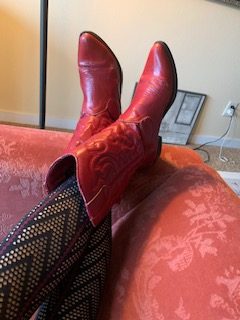A few years ago, I was driving from Houston to Austin on Highway 71, and looking forward to my usual stop at Hruska’s, a convenience store with a  Czech bakery where I always treated myself to a pimento cheese sandwich and a prune kolache. However, I was running late, so I reluctantly passed by and continued on. As I approached Bastrop, I realized I needed gas. A huge billboard announced the cheapest gas in the state at a place called Buc-ee’s. I flipped my blinker and exited the highway only to drive right past this Buc-ee’s place because I thought it was a super Walmart or something. I made a U-turn, came back around, and saw the Buc-ee’s sign. I couldn’t believe it. I was expecting a typical convenience store with a few gas pumps, an oil-stained parking lot, stale coffee, cellophane-wrapped honeybuns with an expiration date well into the next century, and a sign on a dirty, smelly door reading, “Out-of-Order/Port-a-potty Around Back.” Instead, Buc-ee’s had forty-two gas pumps and not an oil stain anywhere on the pavement.
Czech bakery where I always treated myself to a pimento cheese sandwich and a prune kolache. However, I was running late, so I reluctantly passed by and continued on. As I approached Bastrop, I realized I needed gas. A huge billboard announced the cheapest gas in the state at a place called Buc-ee’s. I flipped my blinker and exited the highway only to drive right past this Buc-ee’s place because I thought it was a super Walmart or something. I made a U-turn, came back around, and saw the Buc-ee’s sign. I couldn’t believe it. I was expecting a typical convenience store with a few gas pumps, an oil-stained parking lot, stale coffee, cellophane-wrapped honeybuns with an expiration date well into the next century, and a sign on a dirty, smelly door reading, “Out-of-Order/Port-a-potty Around Back.” Instead, Buc-ee’s had forty-two gas pumps and not an oil stain anywhere on the pavement.
I never pay at the pump, so I went inside and handed the clerk a twenty. “Fill up on pump number—”
“Number eight,” she said. “Red Jeep Compass.”
She noticed my surprise and pointed to the TV monitor. “Hello, welcome to Buc-ee’s. I saw you walking in. First time here? I love your jeans and those cute little zippers at the ankle. And I really love your red boots. You must like red—red car, red boots.” I pointed to my red earrings. “Cool,” she said. The place inside was buzzing, and this sweet, smiling young lady told me I was in the second biggest Buc-ee’s; the biggest was somewhere outside of Houston. Then she told me to take my time and look around. She pointed out the restroom without me having to ask.
I walked down a long, spotlessly clean hallway that looked like an art gallery to a spotlessly clean and roomy restroom with more artwork. A greeter pointed to an available stall. The soap dispenser had lavender-scented soap, and the paper towels were thick and soft. The sinks were shiny clean, and the counters were dry. I didn’t have to rush out with a tissue over my nose to cover a bad smell. I decided I wasn’t in that much of a hurry to get to Austin, so I took my time. I combed my hair, put on lipstick (red), and checked to see if the cute little zippers on my jeans were zipped. Then I cleaned and organized my purse. I looked around and noticed all the females were happy. I washed my hands again, then went to check out the rest of the store.
There were several flavors of fresh coffee, and a display case with fresh salads, fresh fruit, and thick sandwiches, including pimento cheese. And guess what? I found what best is described as a kolache wall. I stood gawking at their kolache display. Besides traditional fruit, a variety of others came with a cream cheese filling: lemon, blueberry, strawberry, apricot, raspberry, peach, apple coconut, and even Nutella. Stuffings for the savory kolaches included brisket, pepperoni, ham and cheese, turkey and cheese, bacon, potato, eggs, and sauerkraut. You could buy sausage kolaches, ground or link, with cheese and even jalapenos. These made me question my vegetarianism.
Studying all those varieties, I realized that the basic kolache I grew up with had undergone a cultural foodie evolution. What was once a well-kept Czech secret in West was now a popular commodity all over the state. But what hasn’t changed is what makes the kolache so deliciously delightful—and that is the dough. What doesn’t go well with sweet, buttery bread? Fill it with whatever you want.
Stuff the dough with crawfish and you can make the Czech version of a lobster roll. Stuff it with feta cheese and Kalamata olives, and you have a Greek kolache. Add a mixture of lentils, potatoes, onion, peas, and curry, and you have a samosa-kolache. This mingling of different national foods reflects the multiculturalism that makes the Lone Star State so great. Something so delectable can’t be kept secret. Nowadays, I rarely meet someone who doesn’t know about kolaches.
I’m happy to report that the Buc-ee’s bakers have perfected the dough, and their kolaches are wonderful. I don’t know who this Buc-ee guy is, but cheap gas or not, I like him. I like that he keeps a clean place and bakes and sells kolaches. I just have one request. “Mr. Buc-ee, please don’t put a Buc-ee’s within a fifty-mile radius of West because my Czech friends and relatives have the kolache market covered.” And that’s the way it should be.
P.S. Next time I’m doing a doubleheader—Hruska’s first (still loyal), then Buc-cee’s. Besides calories, there’s nothing wrong with comparative gastronomics.



well, the news is there building one in Hillsboro ..I’ve been to a Buck-ee’s once. I had never been and my granddaughter said well you at least should go once..so we stopped there she got gas and then we went inside to use to bathroom. I almost had a stroke by the time we walked to the bathroom. Which were the cleanest bathroom’s I’ve ever seen ever. By then I was so tired from the walk and facing the same walk back we didn’t check out much. We did get some snacks. Then we walked 78 miles back to the door and another 38 miles to the car..Buck-ee’s isn’t for old farts..
another bit of horrible news about West. They have built a MacDonald’s and this week our Starbucks opened up. I will not go because I don’t drink coffee and I’d rather cater to our restaurants for food than Starbucks. But both my granddaughters who don’t even live here but visit me are thrilled …philistines. Holler the next time you come to West and I’ll buy you a pimento sandwich and a prune kolache .
Hi Jacque, I heard about McDonald’s and Starbucks. Hard to believe. I’ll take you up on your offer of a pimento cheese sandwich and a prune kolache! Thanks for being a loyal reader.